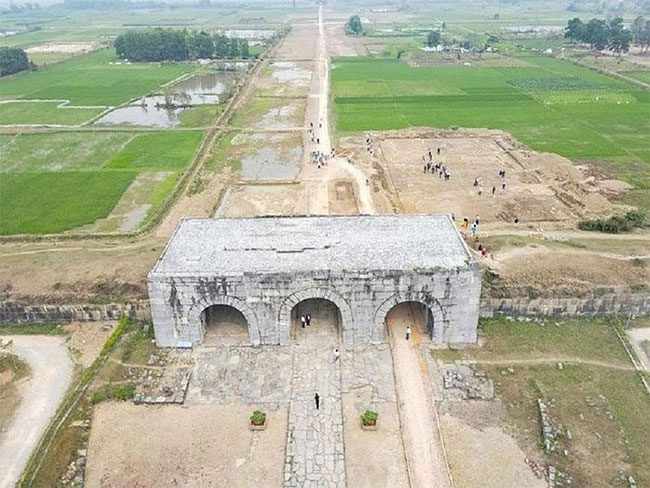The Heritage Conservation Center of the Ho Citadel World Cultural Heritage in Vinh Loc District, Thanh Hoa Province, has collaborated with the Vietnam Archaeology Institute to organize a conference announcing the initial excavation results of the areas inside and outside the four city gates (East – West – South – North) of the Ho Citadel World Cultural Heritage site. This excavation revealed many new findings, including stone bonding techniques.
The excavation took place from September 15 to December 31, 2022, covering an area of 5,000m2. Specifically, the northern gate area was 2,000m2, the southern gate was 2,000m2, the eastern gate was 500m2, and the western gate was 500m2.

Archaeological excavation at the southern gate of the Ho Citadel World Cultural Heritage site.
After several months of excavation, scientists clarified the original dimensions of the gates of the Ho Citadel World Cultural Heritage site. Specifically, the arched gates were constructed by shaping earth into an arch and then bonding trapezoidal stone blocks on top. Once the stone slabs were bonded, the builders dismantled the earth mound to facilitate construction.
Researchers found that the structures of the three walls (East, South, West) were similar in stone bonding techniques, with the size of the stone blocks resembling those of the eastern wall. The base consisted of large foundation stones, topped with 4 to 5 rows of smooth stones; the lower stones were larger, gradually decreasing in size upwards. The inner wall was reinforced with stone, clay, and gravel.
In contrast, the stones used for constructing the northern wall and gate were smaller, with larger bonding gaps and more rows of stones. The outer layers of stones were not smoothed, and the inner layers were not precisely shaped due to multiple material handling and repairs in later stages.

Scientists discovered the stone site inside the southern gate of the Ho Citadel World Cultural Heritage site.
The excavation results indicated that architectural materials such as rectangular bricks, decorative leaf designs from the Tran-Ho period, flat tiles, and curved tiles from the Le period were present. Numerous pieces of glazed pottery from the Tran-Ho and early Le periods were also found, along with several stone balls in the southern and northern gate areas. Overall, the architectural layout of the Ho Citadel is distributed in multiple horizontal and vertical layers, all symmetrically aligned along the Royal Road in the center.
Based on the findings from this excavation and the many new discoveries, researchers and archaeologists recommend that the Ho Citadel Heritage Conservation Center, following UNESCO’s recommendations, the commitments of the Thanh Hoa Provincial People’s Committee, and the Cultural Heritage Law, develop research and conservation plans to maximize the heritage’s value. They also suggest creating research and conservation plans for the following years for submission to the relevant authorities for review and approval.


















































